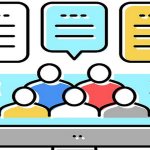At some point in your career, there’s a good chance that you’re going to be required to deliver a presentation about a project. You might be pitching a new idea to your superiors or sharing the results that you were able to achieve with an existing project. Either way, it can be difficult to know where to start.
There are many ways to present a project, from talking informally at the office water cooler to calling everyone into the board room and hitting them with a sit-down presentation. In today’s day and age, with more and more work taking place online and remotely, you might even have to present a project online via Zoom.
Project presentation is as much of an art form as a science, and it’s important to remember that what works for one person might not work as well for another. It’s your job to find the approach that works best for you and to run with it.
Still, there are a few general tips that we find work well for most people, and that’s what we’re going to take a look at today. Here are our tips on the best ways to present a project at work.
 . SOURCE: https://www.pexels.com/photo/man-in-beige-blazer-holding-tablet-computer-3184328/
. SOURCE: https://www.pexels.com/photo/man-in-beige-blazer-holding-tablet-computer-3184328/
How to Present a Project
1. Use video
They say that a picture is worth a thousand words, and video runs at 60 frames (or 60 pictures) per second. Video can be a super useful way to get your message across, whether you’re using third-party video or using a freelancing site to hire an animator to make a simple explainer video or you can try this easy video maker. To enhance your video’s global accessibility, consider integrating a subtitle translation service, allowing viewers from different linguistic backgrounds to engage with your content. If you do pick a third-party video, you can download video converter software to make sure that it’s in a format you can use. You can use an AI voice generator generator as well for voice-over.
2. Skip PowerPoint
Microsoft PowerPoint can be a useful tool, but it can also sabotage your chances of delivering a memorable presentation. That’s because we’ve all been so overloaded by PowerPoint throughout the years that it tends to make our eyes glaze over as soon as someone loads it up. Instead, consider using an online presentation tool to create something more memorable.
3. Use visuals
Visuals might not quite be as powerful as video, but they can still do a great job of communicating information. The good news is that there are a ton of free tools out there with templates that are designed specifically for presentations, and you don’t need to be a graphic designer to make use of them. We find that infographics tend to work particularly well.
Presentation is always crucial in managing projects and marketing. Access to pre-designed PowerPoint templates and Google Slides themes empowers professionals in creating impactful presentations. As a leading presentation services provider for clients across different industries, listing our comprehensive services in your article will benefit your readers.
4. Lead with your passion
Perhaps the single best thing that you can do is to lead with your passion because if people can see that you’re passionate about what you’re talking about, that passion is often contagious. If you can’t summon up that passion, either find someone else on your team who can do it or reevaluate why you’re working on the project in the first place.
5. Get good at project management
Project management is all about making sure that you get the results you want on time and on budget. It can come in useful when it comes to managing the process of developing and presenting your project pitch, but it’s also good to be able to show senior management that you have a project management process in place if they give you the green light to go ahead. The good news here is that there are a ton of tools out there that are designed to help you out with project management, so don’t be afraid to experiment and find a tool that works for you.
 . SOURCE: https://www.pexels.com/photo/man-beside-flat-screen-television-with-photos-background-716276/
. SOURCE: https://www.pexels.com/photo/man-beside-flat-screen-television-with-photos-background-716276/
6. Back it up with documentation
When we think about presenting projects, that normally begins with us thinking about delivering a presentation. That’s all well and good, but you’ll also want to back that up with documentation. One of the most important forms of documentation you’ll need is a project proposal, which should outline how you intend to proceed if you’re given the go-ahead. That way, if your presentation goes well and people want to learn more, you have something you can give to them.
7. Answer questions
It’s always a good idea to open up for questions because there’s a good chance that you’ve missed something in your main presentation. It’s also hard to predict exactly what information people are going to want, and so while you can design your presentation so that you hit all of the key points, a Q&A at the end is a great way to give other people the information that they might need. It can also build engagement with your audience and help to get people on board with your proposal.
8. Get plenty of practice
It should go without saying that practice makes perfect, and that’s even truer with presenting and public speaking than it is in other areas. Building a great presentation is one thing, but being able to deliver it with confidence and fluency is something else entirely. The only way to make sure that you’re at your best is to make sure that you practice your presentation until it’s second nature.
9. Know your audience
Knowing your audience is a must because that’s what will help to make sure that you’re covering the essentials and speaking in a language that they understand. For example, if you’re speaking at a company-wide meeting then you’re going to speak very differently from how you would if you were speaking to the C-suite or to a team of engineers. Knowing your audience is only the first step, though. Once you know who you’re speaking to, you then need to translate that into action by modifying your presentation accordingly.
10. End on a call to action
Last but not least, you should end every presentation with a strong call to action. This concept is borrowed from marketing and the idea is to leave people with some sort of action that you want them to take. In this case, it may be to give your project the green light or to book a meeting with you and your team to learn more.
 . SOURCE: https://www.pexels.com/photo/woman-wearing-gray-cardigan-and-eyeglasses-3184295/
. SOURCE: https://www.pexels.com/photo/woman-wearing-gray-cardigan-and-eyeglasses-3184295/
Conclusion
Now that you know a few of our top tips for successfully presenting projects at work, it’s over to you so that you can put what you’ve learned today into practice.
You should bear in mind here that your goal is to get people to buy into your project and to align themselves with its goals, and so that requires different techniques than you might be used to if you’ve only ever used presentations to share information.
As always, we’d love to hear how you get on, so be sure to let us know in the comments so that we can keep the discussion going. You can also follow us on your favorite social networking sites for more. We’ll see you soon for another article!



